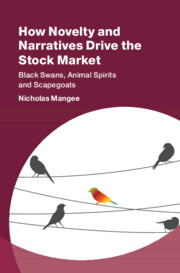Book contents
- Frontmatter
- Dedication
- Contents
- List of Figures
- List of Tables
- Preface
- Acknowledgments
- PART I NOVELTY, NARRATIVES, AND INSTABILITY
- PART II NEWS ANALYTICS AS A WINDOW INTO STOCK MARKET INSTABILITY
- PART III EMPIRICAL EVIDENCE FOR THE NOVELTY-NARRATIVE HYPOTHESIS
- 9 Corporate Novelty and Stock Market Outcomes
- 10 Narrative Intensity and Stock Market Instability
- 11 A Manual Novelty-Narrative Scapegoat Analysis
- 12 Applying Novelty and Narratives to Other Research
- 13 The Future of Novelty, Narratives, and Uncertainty in Finance
- 14 Concluding Thoughts and Future Research
- Appendix A R Code for Bloomberg News Word Cloud and Histogram
- Appendix B The Bloomberg News KU Stock Market Project
- Appendix C RavenPack Terms for Event Output Record
- Appendix D Unscheduled Events from RavenPack
- Bibliography
- Index
10 - Narrative Intensity and Stock Market Instability
from PART III - EMPIRICAL EVIDENCE FOR THE NOVELTY-NARRATIVE HYPOTHESIS
Published online by Cambridge University Press: 23 September 2021
- Frontmatter
- Dedication
- Contents
- List of Figures
- List of Tables
- Preface
- Acknowledgments
- PART I NOVELTY, NARRATIVES, AND INSTABILITY
- PART II NEWS ANALYTICS AS A WINDOW INTO STOCK MARKET INSTABILITY
- PART III EMPIRICAL EVIDENCE FOR THE NOVELTY-NARRATIVE HYPOTHESIS
- 9 Corporate Novelty and Stock Market Outcomes
- 10 Narrative Intensity and Stock Market Instability
- 11 A Manual Novelty-Narrative Scapegoat Analysis
- 12 Applying Novelty and Narratives to Other Research
- 13 The Future of Novelty, Narratives, and Uncertainty in Finance
- 14 Concluding Thoughts and Future Research
- Appendix A R Code for Bloomberg News Word Cloud and Histogram
- Appendix B The Bloomberg News KU Stock Market Project
- Appendix C RavenPack Terms for Event Output Record
- Appendix D Unscheduled Events from RavenPack
- Bibliography
- Index
Summary
Chapter 10 provides insight about whether the periods most likely associated with narrative intensity based on corporate novel events align with statistical breakpoints identified by structural change tests in the relationships driving SP500 and firm-level returns, the VIX volatility index, trading volume, and equity ETF flows. Popular breakpoint tests of structural change are applied to each of the stock market relationships based on common fundamental/risk relationships explored in the literature. The Chow test allows for the narrative intensity periods to be imposed ex ante in testing for breakpoints. The Bai and Perron unknown multiple breakpoint test identifies the most likely points of temporal instability in the time-series relations for comparison to the narrative intensity periods without imposing them ex ante. The analysis finds that structural breaks, in particular those found in aggregate- and firm-level returns, volatility, and fund flow regressions are at least somewhat aligned with the periods of highest, and moderate, KU narrative intensity from Chapter 6.
Keywords
- Type
- Chapter
- Information
- How Novelty and Narratives Drive the Stock MarketBlack Swans, Animal Spirits and Scapegoats, pp. 240 - 264Publisher: Cambridge University PressPrint publication year: 2021



